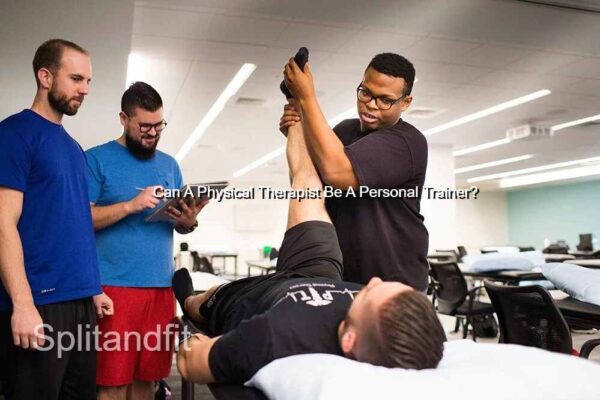In recent years, there has been a growing interest in the intersection of physical therapy and personal training. The question of whether a physical therapist can also serve as a personal trainer has sparked discussions within the health and fitness industry.
This convergence has led to debates surrounding qualifications, legal considerations, and the potential benefits of integrating the expertise of these two professions. As the demand for holistic approaches to fitness and rehabilitation continues to rise, it’s essential to explore the possibilities and challenges inherent in this evolving crossover.
Can a Physical Therapist Be a Personal Trainer?
Physical therapists and personal trainers both play crucial roles in promoting physical well-being, but there are legal, educational, and ethical considerations to be addressed when exploring the potential crossover between these professions.
The increasing demand for integrated approaches to fitness and rehabilitation has sparked discussions around the possibility of physical therapists taking on the role of personal trainers.
Understanding the qualifications, scope of practice, and industry trends is essential to navigating this complex intersection and providing informed insights on this topic.
When considering the education and training required for physical therapists and personal trainers, it becomes evident that each profession follows distinct pathways to qualification and licensure.

Qualifications of Physical Therapists and Personal Trainers
Requirements for Becoming a Physical Therapist
- Academic Degrees: Aspiring physical therapists are typically required to complete a Doctor of Physical Therapy (DPT) program from an accredited institution. This doctoral-level education provides in-depth knowledge of anatomy, physiology, biomechanics, and therapeutic techniques essential for the practice of physical therapy.
- Clinical Training and Internships: In addition to academic coursework, physical therapy programs incorporate extensive clinical training and internships. This hands-on experience allows students to apply theoretical knowledge in real-world settings, develop patient care skills, and gain exposure to various medical conditions and treatment approaches.
- Continuing Education and Licensure: After completing their DPT program, individuals must obtain a state license to practice as a physical therapist. This process involves passing the National Physical Therapy Examination and fulfilling continuing education requirements to maintain licensure. Continuing education ensures that physical therapists stay updated with the latest advancements in their field and adhere to professional development standards.
Training Pathways for Personal Trainers
- Certification Programs: The journey to becoming a certified personal trainer often starts with enrolling in a reputable certification program offered by organizations such as NASM (National Academy of Sports Medicine), ACE (American Council on Exercise), or ISSA (International Sports Sciences Association). These programs cover topics such as exercise science, nutrition, client assessment, and program design, equipping aspiring trainers with the fundamental knowledge required for the role.
- Practical Experience and Mentorship: While certification programs provide a foundational understanding of personal training principles, practical experience and mentorship play a crucial role in skill development. Working under the guidance of experienced professionals allows aspiring trainers to refine their coaching techniques, client communication skills, and adaptability in diverse fitness environments.
- Continuing Education and Recertification: Similar to physical therapists, personal trainers are often required to pursue continuing education and recertification to uphold their credentials. This ongoing learning process ensures that trainers stay informed about emerging fitness trends, evidence-based practices, and specialized training modalities, thereby enhancing the quality of service they offer to clients.
By examining the distinct educational and training pathways for physical therapists and personal trainers, it becomes clear that while there are some overlapping elements, each profession has unique requirements tailored to its respective roles in promoting physical well-being and rehabilitation.
Overlapping Roles and Responsibilities
Defining the Role of a Physical Therapist
- Education and Qualifications: As detailed earlier, a physical therapist typically holds a Doctor of Physical Therapy (DPT) degree, which involves extensive study of human anatomy, physiology, kinesiology, and therapeutic interventions. This educational background equips them with the knowledge and skills required to assess, diagnose, and treat individuals with movement-related impairments and functional limitations.
- Scope of Practice: The scope of practice for physical therapists encompasses a wide range of rehabilitative services, including but not limited to post-injury recovery, pain management, mobility enhancement, and the restoration of optimal physical function. They work with patients across various age groups and medical conditions, utilizing evidence-based techniques to develop personalized treatment plans tailored to each individual’s needs.
- Focus on Injury Rehabilitation and Prevention: One of the primary responsibilities of a physical therapist is to facilitate the rehabilitation process for patients recovering from injuries or surgeries. They employ therapeutic exercises, manual therapy, modalities, and patient education to promote healing, restore mobility, and prevent future impairments. Additionally, physical therapists play a vital role in educating patients about injury prevention strategies and promoting long-term physical well-being.
Explaining the Role of a Personal Trainer
- Certification Requirements: Personal trainers are required to obtain certification from recognized organizations, which involves demonstrating proficiency in exercise science, client assessment, program design, and ethical practices. These certifications validate the trainer’s ability to design safe and effective fitness programs tailored to individual client goals and needs.
- Scope of Practice: Personal trainers focus on guiding clients through fitness training and exercise programming aimed at improving overall health, strength, flexibility, and endurance. They work with diverse populations, including individuals seeking general fitness, weight management, athletic performance enhancement, and specialized training for specific health considerations.
- Emphasis on Fitness Training and Exercise Programming: The core responsibility of a personal trainer revolves around designing and implementing customized workout routines, providing guidance on proper exercise techniques, and motivating clients to achieve their fitness objectives. They often collaborate with clients to establish realistic goals, monitor progress, and adapt training programs as needed to ensure continuous improvement and client satisfaction.
Both physical therapists and personal trainers share a common goal of promoting physical well-being, their roles and responsibilities are distinct, reflecting the specialized expertise and focus of each profession.
Physical therapists primarily address rehabilitation and mobility concerns, drawing from their extensive clinical training, while personal trainers specialize in fitness training and exercise programming, leveraging their expertise in exercise science and personalized coaching.
Scope of Practice for Physical Therapists and Personal Trainers
Areas of Expertise for Physical Therapists
- Rehabilitation of Musculoskeletal Injuries: Physical therapists possess specialized knowledge and skills to rehabilitate a wide range of musculoskeletal injuries, including sprains, strains, fractures, and post-operative conditions. They utilize therapeutic exercises, manual techniques, and modalities to restore function, reduce pain, and improve mobility following injury or surgery.
- Pain Management: Addressing pain is a critical aspect of a physical therapist’s expertise. They employ various modalities such as heat/cold therapy, electrical stimulation, and manual therapy to alleviate pain, enhance tissue healing, and improve the overall quality of life for individuals experiencing acute or chronic pain.
- Functional Movement Assessment and Correction: Physical therapists are adept at conducting comprehensive assessments of an individual’s movement patterns and biomechanics. By identifying movement dysfunctions and imbalances, they can develop tailored treatment plans to correct these issues, optimize functional movement, and reduce the risk of future injuries.
Specializations in Personal Training
- Strength Training: Personal trainers often specialize in designing strength training programs aimed at improving muscular strength, endurance, and hypertrophy. Through the use of resistance training exercises and progressive overload principles, they help clients develop greater overall strength and functional capacity.
- Cardiovascular Conditioning: This specialization involves creating tailored cardiovascular exercise regimens to enhance heart health, endurance, and overall cardiovascular fitness. Personal trainers design workouts that include activities such as running, cycling, and high-intensity interval training (HIIT) to address their clients’ specific cardiovascular goals.
- Sports-Specific Training: Many personal trainers specialize in providing sports-specific training for athletes looking to improve performance in their chosen sport. This specialization involves developing targeted training programs tailored to the demands of a particular sport, focusing on areas such as agility, speed, power, and sport-specific movement patterns.
In essence, the focus areas for physical therapists and personal trainers reflect the specialized expertise and interventions each profession provides. Physical therapists excel in addressing musculoskeletal rehabilitation, pain management, and functional movement correction, while personal trainers specialize in strength training, cardiovascular conditioning, and sports-specific training, catering to diverse fitness needs and objectives.
Analyzing the legal and ethical aspects of practicing in both capacities
Certainly, analyzing the legal and ethical aspects of practicing as a physical therapist and personal trainer is crucial for understanding the professional responsibilities and considerations within each role.
Legal and Ethical Aspects in Physical Therapy
- Legal Compliance: Physical therapists are required to adhere to state licensing regulations and practice within the scope of their licensure. This includes obtaining and maintaining appropriate licensure, following state practice acts, and complying with any relevant legal requirements governing the profession.
- Confidentiality: Physical therapists must uphold strict standards of patient confidentiality and privacy by health information privacy laws such as the Health Insurance Portability and Accountability Act (HIPAA). This entails safeguarding patient medical records and information from unauthorized disclosure.
- Informed Consent: Before initiating treatment, physical therapists are ethically obligated to obtain informed consent from patients or their legal guardians after explaining the proposed interventions, potential risks, and expected outcomes. This ensures that patients are fully aware and agree to the treatment plan.
- Professional Boundaries: Maintaining professional boundaries and avoiding conflicts of interest are critical ethical considerations for physical therapists. They should prioritize the welfare of their patients and refrain from engaging in any activities that could compromise professional objectivity and integrity.
Legal and Ethical Aspects in Personal Training
- Certification and Liability: Personal trainers are typically required to hold valid certifications from recognized organizations, and it’s important to practice within the scope of these certifications. They must also carry liability insurance to protect themselves and their clients in case of unforeseen circumstances during training sessions.
- Client Safety and Well-being: Ethical personal trainers prioritize the safety and well-being of their clients by conducting thorough assessments, designing appropriate exercise programs, and ensuring proper supervision during training sessions. They should also be knowledgeable about contraindications and precautions for specific exercises based on a client’s health status.
- Professional Conduct: Personal trainers are expected to conduct themselves professionally, maintaining respectful and ethical relationships with their clients. This includes providing honest and accurate information, avoiding inappropriate behavior, and refraining from making false claims or promises regarding fitness outcomes.
- Business Practices: For personal trainers operating as independent contractors or business owners, understanding and adhering to local business laws, tax regulations, and contractual agreements is essential for legal compliance and ethical business practices.
Client Perspective and Industry Trends
Target Clientele for Physical Therapists
- Individuals Recovering from Injury or Surgery: Physical therapists often work with individuals who are recuperating from various injuries, such as fractures, sprains, or post-operative rehabilitation. Their focus is on restoring mobility, strength, and function while minimizing pain to aid in the patient’s recovery process.
- Patients with Chronic Conditions (e.g., Arthritis, Fibromyalgia): Physical therapists play a pivotal role in managing chronic conditions by developing tailored exercise and treatment plans to alleviate pain, improve flexibility, and enhance overall quality of life for patients living with conditions like arthritis, fibromyalgia, or degenerative joint diseases.
- Athletes Seeking Performance Enhancement and Injury Prevention: Physical therapists also cater to athletes, providing specialized interventions aimed at enhancing athletic performance, preventing sports-related injuries, and rehabilitating athletic injuries. They often collaborate with sports medicine professionals to optimize an athlete’s physical capabilities and mitigate injury risks.
Target Clientele for Personal Trainers
- General Population Seeking Fitness Improvement: Personal trainers work with a broad spectrum of clients seeking to improve their overall fitness levels, lose weight, gain muscle, or enhance their general health and well-being. They design customized exercise programs and provide motivational support to help clients achieve their fitness goals.
- Athletes Preparing for Competitions: Personal trainers often specialize in coaching athletes who are training for specific competitions or events. They focus on sport-specific conditioning, strength training, agility drills, and overall performance enhancement to help athletes excel in their respective sports.
- Special Populations (e.g., Seniors, Pregnant Women): Personal trainers may also cater to special populations such as seniors or pregnant women, designing safe and effective exercise programs tailored to the unique needs and considerations of these individuals. This includes exercises to improve balance, flexibility, and overall functional ability.
The target clientele for physical therapists encompasses individuals recovering from injury, managing chronic conditions, and athletes seeking sports-related interventions. On the other hand, personal trainers cater to the general population seeking fitness improvements, athletes preparing for competitions, and special populations with specific exercise needs. Both professions demonstrate a commitment to meeting the diverse health and fitness requirements of their respective client populations.
Frequent Question Answers
| Question | Answer |
|---|---|
| Can a physiotherapist be a personal trainer? | While there can be overlap in knowledge and skills, being a physiotherapist (physical therapist) and a personal trainer are distinct professions with different educational and licensing requirements. Physiotherapists may be able to also work as personal trainers, but specific regulations may vary by location. |
| Is a physical therapist the same as a personal trainer? | No, a physical therapist and a personal trainer are not the same. A physical therapist is a licensed healthcare professional who helps individuals recover from injuries or manage chronic conditions, while a personal trainer focuses on fitness training and exercise programs. |
| Can a PT work in a gym? | Yes, physical therapists can work in a gym setting, providing rehabilitation services, exercise prescriptions, and injury prevention programs. |
| What qualifications do you need to be a PT? | To become a Physical Therapist (PT), one typically needs a Doctor of Physical Therapy (DPT) degree from an accredited program, as well as passing the National Physical Therapy Examination (NPTE). Specific requirements may vary by country. |
| How do I become a PT trainer? | To become a personal trainer (PT), one usually needs certification from a reputable organization such as NASM, ACE, or ACSM. Additionally, gaining relevant experience and knowledge in exercise science and human anatomy is important. |
| Why I quit being a personal trainer? | Reasons for quitting a career as a personal trainer can vary widely from burnout, career change, lifestyle adjustments, or pursuing other professional interests. Each individual’s reason for leaving the profession is unique. |
Conclusion
For aspiring physical therapists and personal trainers, several key points and actionable insights can be gleaned from the discussion:
- Professional Focus: Physical therapists should prioritize skill development in injury rehabilitation, chronic condition management, and sports-related interventions, while personal trainers should focus on designing customized fitness programs for diverse client populations.
- Legal and Ethical Considerations: Both professions require a thorough understanding of legal and ethical responsibilities, including maintaining professional boundaries, upholding confidentiality, and practicing within the scope of certifications and licensure.
- Client-Centric Approaches: Emphasizing a client-centric approach is essential for success in both fields. Physical therapists should tailor treatment plans to meet individual patient needs, while personal trainers should create personalized workout regimens aligned with clients’ fitness goals.
- Continuous Learning: Continuous education and staying abreast of the latest research, techniques, and industry trends are vital for professional growth and providing high-quality care to clients.
- Collaboration and Communication: Building effective communication skills and fostering collaborative relationships with other healthcare professionals (for physical therapists) or clients (for personal trainers) is crucial for delivering comprehensive care and achieving positive outcomes.
- Business Acumen: For personal trainers operating independently, understanding business practices, client retention strategies, and marketing techniques can contribute to a successful and sustainable career.
In conclusion, aspiring physical therapists and personal trainers should prioritize client-centered care, professional development, ethical practice, and ongoing education to excel in their respective fields and make meaningful contributions to the health and well-being of their clients.
Sources
- Physical Therapist, Personal Trainer, or Both?
- Source: PhysioFixx PT
- Legal Issues for Physical Therapists Who Provide Fitness Services
- Source: Simons & Associates Law (PDF)
- Are any PTs also working as personal trainers?
- Source: Student Doctor Forums
- Let’s Talk the Difference: PT vs. Personal Trainer
- Source: KC Physical Therapy






Leave a Reply